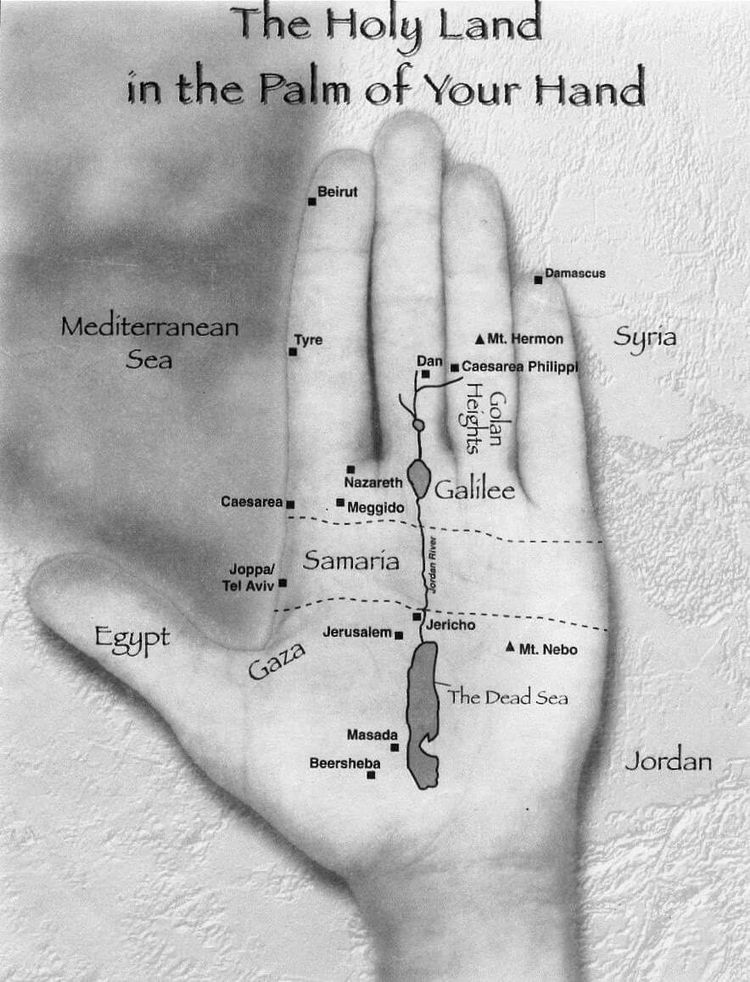“Look at what I’e done for you: I’ve placed in front of you Life and Good Death and Evil.” (Deuteronomy 30:15 MSG)
I still visit Israel daily in my mind. The Old Testament and the gospels all made so much sense there. I’m very much a visual learner and on our pilgrimage, my mind’s eye could see the stories of the Bible unfold. Our journey grounded my faith and grew my hope of heaven; my thirst for the new Zion has awakened in ways I lack the words to express.
Before I went to Israel, I studied the map. I wanted to have an idea of where things were, to pre-orientate myself so I could fully focus on everything our guide had to say. In my research, I came across a palm-sized guide to Israel. I’m not a tattoo person, but this map would be some seriously awesome ink on my left hand! My children talked me out of it, of course. “Nerdiest tattoo ever, Mom.”

So you’ll see from the map, how Isreal hosts two seas. They’ve always been there, documented since the children of Israel first entered the land thousands of years ago. The Sea of Galilee and the Dead Sea (referred to in scripture as the Salt Sea; more on that in a moment). It was apparent to me at first glance how the Dead Sea is three times the size of the Sea of Galilee.


What the map in your hand cannot show you is the profound quality of life gap between these two bodies of water. The land near the Sea of Galilee is green, almost lush, populated and pleasant. The Sea of Galilee provides life: fish, fresh water, growth, tourism and commerce. Conversely, the Dead Sea is aptly named. The surrounding territories are arid, hot, unoccupied. Nothing and no one lives there. No growth springs from it’s banks, only crusty, calcified salt deposits collect on it’s edges. What’s more, it stinks. The sea itself is salty, but it’s also muddy and full of sinkholes. There are no thriving communities on the edge of the Dead Sea except for the folks who are trying to make a living by selling death’s wares: sea salt and mud scrubs.
It’s interesting to me how the Lord built the illustration life and death right into the geography of His Promised Land. He clearly shows us, it’s easier to be a dead sea than a living one; three times easier in fact. See, both seas receive deposits; pain and death visit them equally. But one sea has learned how to let go. The living sea realizes that hanging on to everything that flows into it will cause it to become brackish and bitter, that pain contained is life-altering and destructive.
A life that refuses to let go of insult and injury becomes backed up with hurt, to a point where nothing new can grow and no one wants to come near. Our souls stagnate: move from living waters to a mud puddle: from being a place of refreshment to a place of dire thirst.
I mentioned how the Bible called the Dead Sea the Salt Sea, because it wasn’t always so salty as it is today. It is becoming saltier all the time. What a commentary on hurt people: when we can’t let go, we grow more and more dead from the inside out.
On the other hand, if we can have some outflow, if we can allow the Spirit of God to help us to forgive, to offer grace, to trust again, we can be healed and our waters will remain sweet. I wish you could see how the Galilee bursts with life. Green surrounds it’s borders, irrigation is carried away to distant fields and land is made better because of it’s generous spirit.
The difference between a living sea and a dead sea lies in the decision to let go. Letting go determines the ph level of our heart; whether we’ll grow sweet or bitter, whether we’ll offer life or death. I’m not going to sugar-coat it, it’s hard work to be a life-giving body. The Dead Sea is three times as big as the Sea of Galilee for a reason; it’s far easier to hang on to our hurts and let them fester. But the end results of letting go are well-worth the effort.
Jesus offers us His Spirit, His strength to help in this process. We come to Him with our burdens. We lay our hurts in His hands and at His feet. He washes us clean and restores our soul. His Spirit spills through, refreshing us from within. We become overflowing vessels of His love and then we can offer His life to others.
“He cried out, “If anyone thirsts, let him come to me and drink. Rivers of living water will brim and spill out of the depth of anyone who believe in me this way. Just as the scripture says.” (John 7:38 MSG)
Lord, we long to be living waters. We realize this is a tough transformation, that we tend toward dead sea living. Strengthen us, speak to us as we address our hurts and hangups. Give us a visual of what dead sea living ultimately will look like. Grab our hearts toward Galilee, towards full life for us and for others. Inhabit our frames, fill us with Your Spirit and let us let go as You do so obediently. Amen.